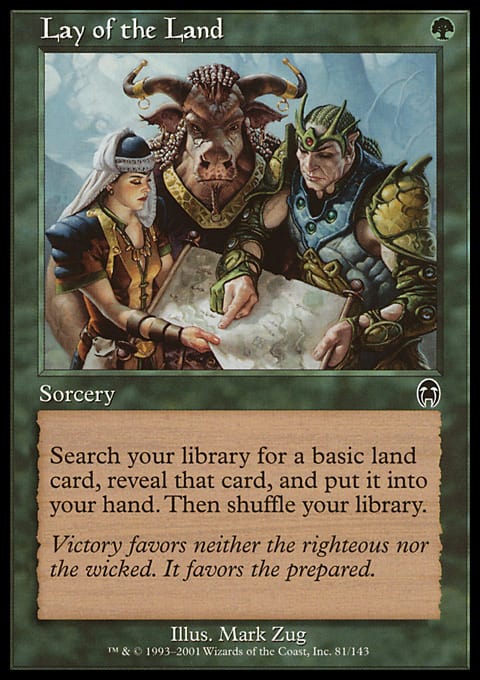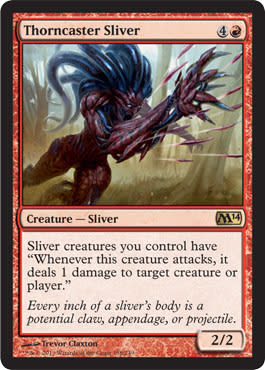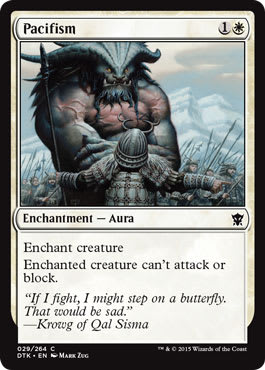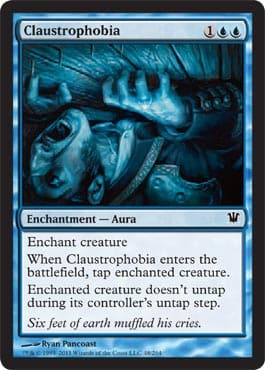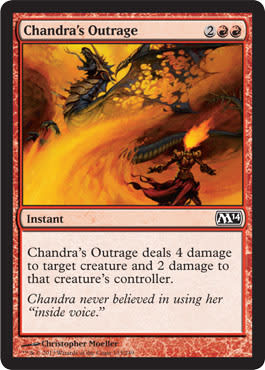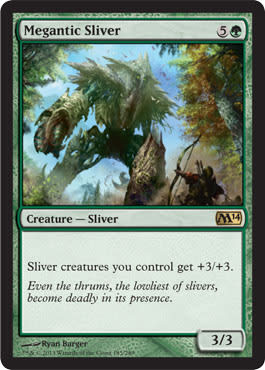Hey there! This week, I’ll be taking my first look at the Limited environment offered to us by Magic 2014. As the full spoiler was just released a few days ago, I have of course not had the chance to play with the set, so these thoughts are purely theoretical. I hope they will still help you conquer those local prereleases! In this article, I will start by talking about M14 Limited in general and then move on to talk about each color’s weakness and strengths along with my Top 5 picks for each color. I will mainly be talking about the commons in the set, as they are the bread and butter of Limited Magic.
General Thoughts
The first thing of note is that fixing is not very plentiful in this format. At common, you have access to Shimmering Grotto, Verdant Haven, and Lay of the Land. While I think Verdant Haven is decent because it ramps and fixes, Lay of the Land is quite lackluster. Shimmering Grotto has the advantage of letting you splash several colors with just one fixer, but at the same time, it does basically make your spells that you cast through it a full turn slower. This is not a major concern if you are only splashing one Pacifism in your U/B deck, but it is a very awkward fixer if you have something resembling a straight three-colored deck.
What this lack of fixers means is that most decks will be two colors. Green decks can much more easily add a third or even fourth color thanks to the aforementioned two common fixers—as well as Manaweft Sliver in the uncommon slot. Looking at the most powerful commons (more on these later), the only one I would really consider splashing is Pacifism. I think it’s nice that the premium cards in each color cost double-colored mana to make splashing them harder, rewarding the people who stay on target with a color.
My first impression would be that this format is slightly on the slower side, about the same as M13. Sealed is naturally always slower, and the true and tried concept of bombs-plus-removal should carry you a long way. This means you should try to fit as many of the bombs you open and as much of the removal that you can into the deck you are building. As you can expect the game to go on for a fair number of turns, you do not need to be all that scared of being run over if you have an awkward curve.
Slivers
One of the main things people have been excited about is the return of Slivers. While I’m in the camp that would rather have had the old design, where Slivers give bonuses to all Slivers and not just the ones you control, I do understand the reasoning for making the change. I think it will be interesting to see how this tribal synergy will shape the M14 Limited format. There are a total of fifteen Sliver cards in M14, with red, green, and white having four each, and with blue and black only having one each. As an addition, there is even a colorless Sliver available. This means that in Limited, you will rarely play blue or black in your Slivers deck unless you have some very good fixing and happen to pick one of these two rare Slivers. And opening a rare Sliver is probably among the most common reasons to draft this deck, as Megantic Sliver, Bonescythe Sliver, and Thorncaster Sliver are all very good cards.
As you primarily want to be in the Naya colors, I think the main trick is to try to have your core be two of the three colors, splashing some cards from the third color. Having green as one of your base colors will probably be the most common, as the mana-fixing available in green goes a long way toward helping you cast all the spells in your deck. One of the problems I can see with the Sliver deck is that most of the Slivers are good to decent on their own, so other players will end up picking them up from weak boosters with no other playables in their colors. If the Slivers were even more reliant on synergy with each other and individually weaker, you would not have this problem. A good example is Predatory Sliver, which among of the most important cards in a dedicated Sliver deck but also perfectly fine as a Grizzly Bears in any other green deck. The exceptions here are Striking Sliver and Hive Stirrings, as those two are not very exciting outside of a dedicated Sliver deck, so you should expect to see those fairly late.
I have a feeling that the Slivers archetype will be hard to judge correctly before having played with it a number of times, so I will try to bring you a second look at it in a few weeks’ time—once I’ve actually had a chance to do some drafting.
White
White has a fair number of good cards. I’ll start with my Top 5 and then give some motivations.
Pacifism is clearly number one here, with the other four on this list being more interchangeable. Dawnstrike Paladin seems like a nightmare against any aggressive deck, and if you ever are able to equip or enchant it, you should be strongly in control of the game. Charging Griffin is able to attack through most other flyers as a 3/3 even though it does die to Shock. Master of Diversion is a very good tapper in an aggressive deck and reminds me a lot of Haazda Snare Squad. Celestial Flare looks to be best in a defensive deck, and even though it is by no means premium removal, any removal is usually very welcome in Limited.
Blue
Blue sees some very solid cards this time around. There is a fair number of flyers and even some good removal. Blue seems best-suited for some sort of tempo deck, or then a more controlling deck, taking full advantage of Archaeomancer.
Claustrophobia is number one here because it is a removal spell that handles most threats. Messenger Drake is a solid 3/3 flyer with an upside, and Nephalia Seakite should always be solid, even when you aren’t able to ambush with it. Some of these cards are better in certain decks than in others, as is to be expected. Trained Condor and Time Ebb are much better in aggressive decks than in defensive ones, while Nephalia Seakite is better if you are slightly more defensive.
Black
Black is a bit thin, and the creatures in particular are not all that exciting. Some of the best black cards require a heavy commitment, so black is not really something you are looking to splash.
Liturgy of Blood is very good as an unconditional removal spell, and when you are able to use the mana for another spell, it can be very brutal. Quag Sickness does require you to be heavy black, but it does take out most midsized creatures. Accursed Spirit is among the few good creatures, and Deathgaze Cockatrice is flexible, as it can either trade for bigger creatures or hit for 2 in the air. Wring Flesh mainly makes the list because it is so cheap and because it is not difficult at all to trade it for a more expensive creature in combat.
Red
Red seems to have some fine aggressive options this time even though I think the red cards in M13 were slightly better.
Chandra's Outrage is quite clearly the best card in red, with the other being fairly far behind. Marauding Maulhorn is a very aggressive common and can quickly kill your opponent when combined with some combat tricks or removal. It even becomes better if you happen to be drafting green and red for some of the Beast synergies. Shock is a decent removal spell, as there seem to be a lot of small creatures in this format, and costing only 1 mana is a big bonus. Pitchburn Devils is surely better now than it was back in Innistrad, and Academy Raider seems to be a good version of Looter il-Kor.
Green
As has been the trend in recent years, green has a very impressive collection of creatures. Unfortunately, green does not have a good removal spell like last time, as Hunt the Weak is not quite Prey Upon.
Rumbling Baloth is a very beefy creature for a common, and Giant Spider is great as usual in basic-set Limited. Rootwalla excels at being aggressive, while Deadly Recluse is more of a defensive card, giving you time to set up if you have a slower deck. I’m not quite sure about Advocate of the Beast, as it does require the ability triggering for it to be good. But if you have enough Beasts in your deck, it should be sweet.
Conquering the Prerelease
As I stated earlier, I think the basics of Sealed deck should be true also for Magic 2014 Sealed deck. Place high value on your bombs, removal, and evasive creatures, along with any card advantage you can find. Most decks you are going to face should be fairly slow, so consider being on the draw rather than on the play. Being on the draw can often be correct in Sealed even though I often err on the side of caution and still choose to play first. Slivers will most likely not work all that well in Sealed, aside from playing the solid ones as just generic creatures. Don’t try to overload on the Sliver theme unless you actually have a bunch of them.
I wish you the best of luck to those of you playing in prerelease events this weekend; I hope you will also have a lot of fun! I will try to find time to play in one or two events this weekend at our local game store. And I will need all the practice I can get before the World Magic Cup in about three weeks’ time.
I kept the analysis in this article quite brief, as planned. If I would go through the details of all the five colors, it would take several articles’ worth of text. Also, as the set has not even been released yet, all I can do is theorize about the format. I do plan on bringing you some more in-depth articles on the M14 Draft format in the coming weeks.
As always, if you have any kind of questions, comments, or suggestions, please contact me either via Twitter or the comments section below. I’d love to hear what you would want me to write about in the future.
Thanks for reading,
Max
@thebloom_ on Twitter
Maxx on Magic Online
You can find my music on: http://soundcloud.com/bloomlive














